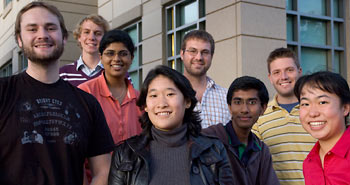New advisory group to help map campus’s technological future
Berkeley students will offer up their IT expertise and insights on the Student Technology Council, an advisory group that will help develop new, scalable, and green IT projects.
February 9, 2010
Students depend on technology for everything from academic research to social networking, so it’s no surprise they expect Berkeley’s services to operate 24/7. The university, however, isn’t keeping pace with today’s “digital natives,” says Shel Waggener, the campus’s chief information officer and associate vice chancellor for information technology.

Student Technology Council members Andrew Blum, Robin Greving, Krithika Muthukumar, Katy Nomura, Josh Harmsen, Seshadri Mahalingam, Bradley Froehle, and Iris Tien. (Wendy Edelstein photo)
Waggener predicts that future generations of students will have even greater expectations, and will demand “a speed of delivery and a customization of environment that we just don’t understand.”
Seeking guidance, Berkeley’s CIO decided to turn to experts — the students themselves. Last summer, he launched an advisory group, the Student Technology Council, to expand the campus’s thinking about technology. “Many of our systems were designed to accommodate Berkeley’s business processes or the needs of the institution” — areas that don’t necessarily address what’s at the top of students’ minds, says Waggener.
Eight undergraduate and grad students with wide-ranging academic interests have come on board. The STC will give current students the opportunity to have input into technical decisions that will affect future students, says Waggener. Those future students will begin arriving in two or three years, he notes.
“What I had as a freshman [at another institution] surpasses what Berkeley delivers to students now,” observes Josh Harmsen, a fourth-year grad student in ecosystems sciences and an STC member. “Why is this happening at a so-called technology campus like Berkeley?” asks Harmsen.
Short-lived things of beauty
Projects will reflect students’ concerns: “How important is green? How important is wireless or mobile? What about anonymity? Do students want opportunities to be more anonymous in their engagement with community members?” asks Waggener, who hopes all of the campus’s technical leaders will benefit by the STC gathering and sharing information about students’ technology priorities.
Waggener, who serves as an ex-officio member of the council, anticipates the proposals the STC selects will be “lightweight” and “quick to develop.” He offers possible examples: a technology project to support a virtual laboratory, an iPhone app indicating the distance between campus buildings that highlights nearby parking or bike racks, or an online 3D virtual world designed for student groups. Many of the endeavors will be “butterfly projects — they will be beautiful for a short time and then flutter away.”
The STC will select initiatives to work on and review student proposals, then support and bring approved plans to fruition. It will provide “a formal mechanism” that will allow students to “engage, develop, and create,” says Waggener. It also will collaborate with campus entities such as Educational Technology Services, bSpace, Berkeley Wireless Research Center, Big Ideas @ Berkeley, the Campus Technology Council, and academic departments.
Also critical in these tight budgetary times, the STC’s projects will be low-cost, primarily funded from grants and donations procured by the Office of the CIO and the STC itself. In addition, Information Services and Technology will provide technical support when an STC project or STC-funded project must integrate with the current campus-computing environment. Since future students will arrive with even higher expectations, most of the projects will be flexible — not exclusively tied to improving current applications or embarking on new activities, but instead a blend of the two, says Waggener.
In a first initiative, STC members are helping to assess e-readers for Berkeley students. Currently, students buy large, expensive paper readers and faculty have to contend with copyright issues. The campus has several efforts underway to evaluate e-textbook options. The council plans to explore the cost as well as potential educational and environmental impacts of moving to such a solution, including what services and systems the campus would need to provide to support wide deployment of e-readers.
The e-reader is only one potential STC project. “Our main goal is to amplify the voice of the students” — not to presume the group knows what’s best for the entire student body, says STC co-chair Andrew Blum, a senior majoring in rhetoric and a second major he fashioned in science, technology, and society. “That’s why the proposal process is more important than our own initiatives.”
Anyone with an idea or suggestion for future projects can submit a proposal at the STC’s website. The council is seeking proposals with new, green, and scalable IT solutions. Students will be able to weigh in on proposed plans via bSpace, where the STC will conduct polls. Waggener wants to tap the collective wisdom of the entire student body — not just the technophiles.
Waggener sees the STC as an alternative to “a static committee that looks at the world through the campus’s eyes.” Instead, he anticipates that every year, new Berkeley students will submit fresh, relevant ideas. “Students can bring enormous creativity to the table that we can tap into” and support, says Waggener.
“We’re in an explosive period of creation,” Waggener says. “It’s a little scary for somebody like me who is used to developing a requirements document, analyzing all the options, and then selecting the right solutions and building a pilot version before the final model. But trying to control how people collaborate isn’t in the nature of what’s happening. Embracing the chaos is a good thing.”
Also: Student Technology Council’s Facebook group